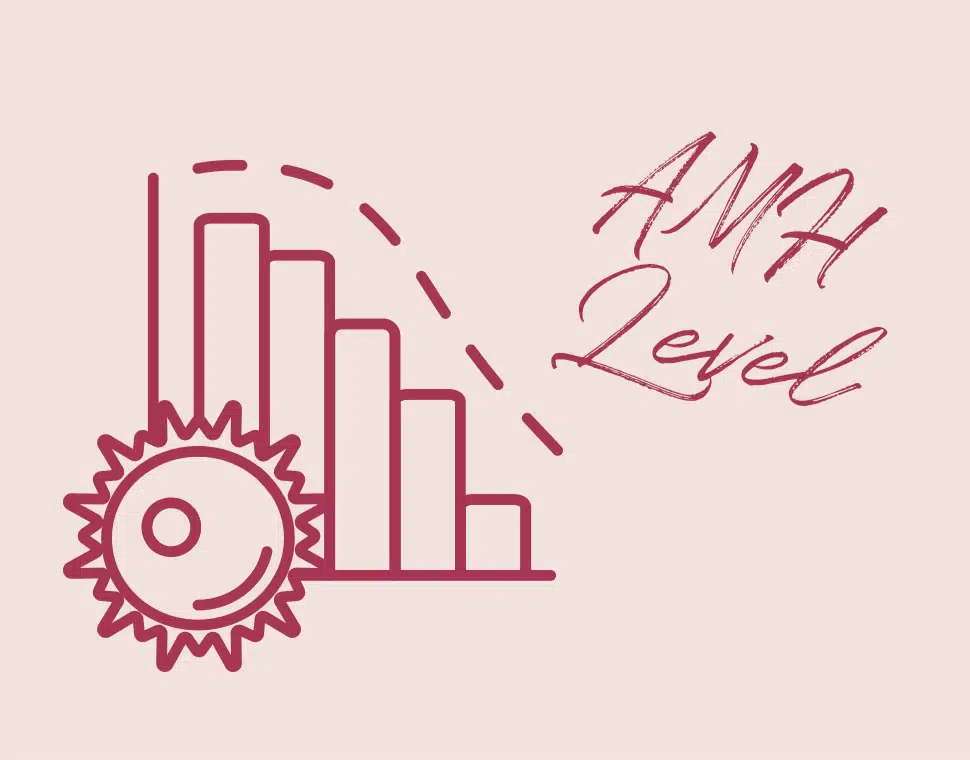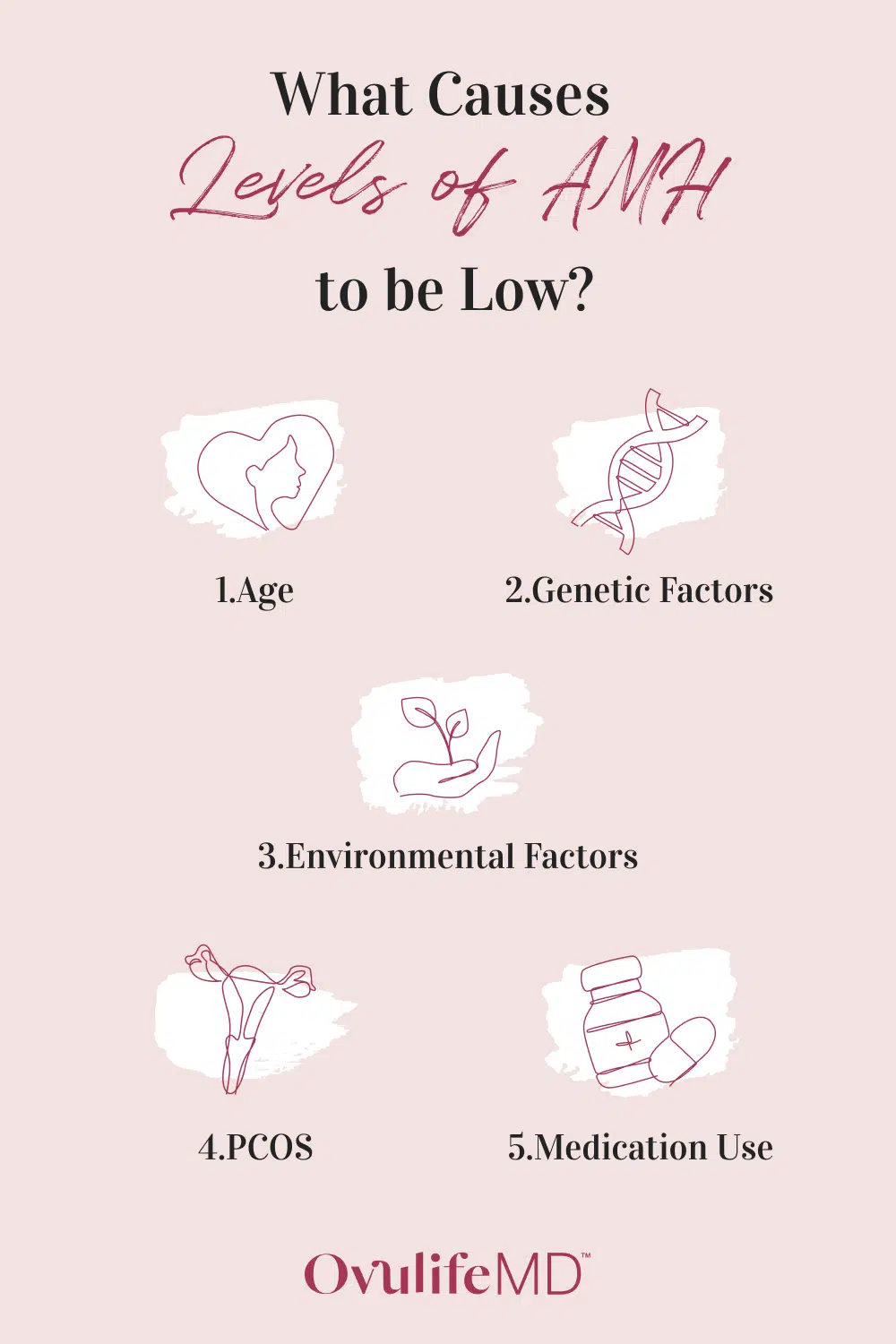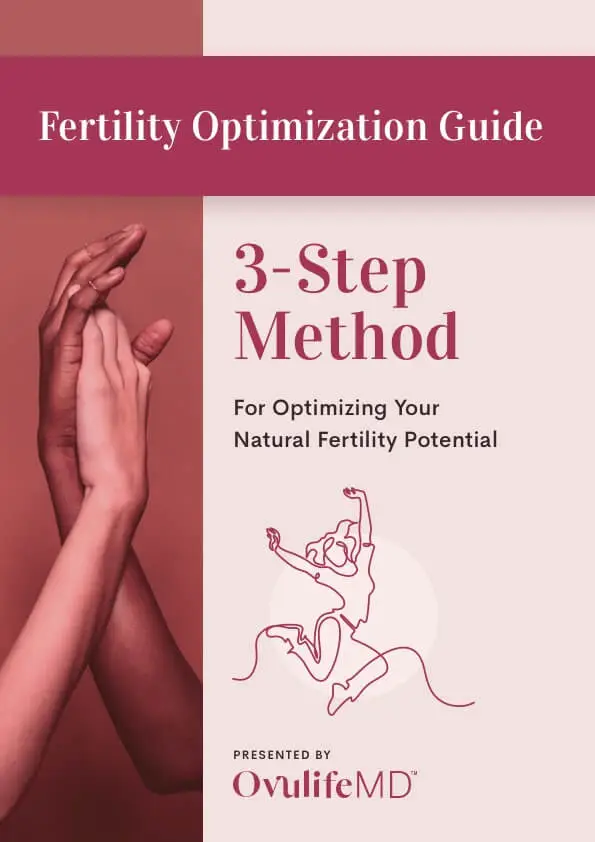Glad to hear 🙂 Thanks for letting us know!

Ever wonder if there was a way to “check your fertility” with a simple blood test?
Or what your anti-mullerian hormone (AMH) level actually means?
And if there’s a way to increase AMH?
Well, you’re not alone!
Here’s a quick overview of what you’ll discover:
What is anti-mullerian hormone (AMH)?
Anti-mullerian hormone (AMH) is a glycoprotein made by granulosa cells, which are teeny tiny cells that line the ovary’s resting follicles (antral follicles). It’s an overall indicator of the number of eggs a woman has remaining.
How do you test AMH?
AMH can be evaluated via a serum sample which can be provided by a typical blood draw or a blood spot (finger prick). Unlike other markers of ovarian reserve, AMH can be tested anytime throughout the menstrual cycle.
Understanding Your AMH Results
Serum anti-mullerian hormone levels in adult women correlate with egg quantity/number of eggs remaining (hence its use as a marker of ovarian reserve) and best predict response to ovarian stimulation with injectable gonadotropins (the injectable medications used in IVF). Normative levels are determined by age and the assay used.
Contrary to popular belief, an AMH test does not predict the likelihood of getting pregnant, live birth, infertility, or fertility (but more on that below).
-

High levels:
High AMH levels are commonly seen in women with polycystic ovarian syndrome (PCOS) or younger women in general. Higher AMH is associated with an increased risk of ovarian hyperstimulation syndrome (OHSS) so medication regimens and IVF treatment protocols can be chosen to reduce the risk accordingly. A high AMH does not equal increased fertility or infertility for that matter. Again it’s a marker of egg number. Higher doesn’t always mean better.
-

Normal levels:
Normal AMH levels suggest a predictable response to injectable gonadotropins (IVF medications) and that you have an expected egg reserve remaining based on your age. Again, a normal AMH does not guarantee fertility or a favorable outcome with treatment.
-

Low levels:
Low AMH levels and lower limits of normal are determined by age as noted above. In general, based on age the lower limits of normal are as follows (1):
- 0.5 ng/mL for 45 years
- 1 ng/mL for 40 years
- 1.5 ng/mL for 35 years
- 2.5 ng/mL for 30 years
- 3.0 ng/mL for 25 years
Some clinics will use an AMH cutoff of < 0.7 ng/mL or < 1ng/mL to be considered a “low level” at all ages. Low AMH levels have been associated with an earlier age of menopause (2-4), diminished ovarian reserve (DOR) (fewer eggs) with a poorer response to IVF medications (5, 6), and a higher cycle cancellation rate (7). Interestingly, it has not been associated with fertility or the likelihood of getting pregnant. Women with lower AMH often need more aggressive IVF treatment regimens to get a favorable response.
How is Follicle Stimulating Hormone (FSH) used with AMH?
Follicle-stimulating hormone (FSH) is the hormone made by a tiny area in the brain called the anterior pituitary that is sent out early in the menstrual cycle to recruit a follicle each month. When a serum FSH is drawn on menstrual cycle day 2 or 3 with a serum estradiol level it is a good indication of how well the ovary is communicating with the brain.
A high FSH early in the menstrual cycle indicates poor ovarian production of hormones as a part of a decreasing number of follicles/eggs or diminished egg reserve. High estradiol and low FSH can be interpreted similarly.
Unlike AMH, FSH cannot be drawn at any point in the menstrual cycle and must also be drawn with estradiol to be interpreted correctly. It is also highly variable from one cycle to another. And while a high FSH level (generally > 10 mIU/mL) is a good predictor of diminished ovarian reserve and poor ovarian response to gonadotropins, a normal FSH is less predictive.
If an initial FSH is abnormal or doesn’t match AMH, it is typically repeated given the high variability as noted above which can help confirm what treatment regimen might be best.
Limitations of AMH
Although AMH level strongly correlates with ovarian response to gonadotropin stimulation in IVF, it is a poor predictor of non-pregnancy, infertility, or fertility. Meaning just being a woman has a low AMH, that doesn’t mean she has a lower chance of getting pregnant (8).
Further, data has shown that AMH levels are a poor predictor of pregnancy and live birth with the use of assisted reproductive technologies (ART) and in vitro fertilization (IVF) (9, 10). This would support the fact that AMH best predicts egg quantity, but not the quality of eggs.
What Causes Levels of AMH to be Low?
When interpreting AMH levels, one must also take into account all possible influencing factors to make the most accurate assessment of ovarian reserve or the remaining egg number.

-

Age:
Women are born with ~2 million follicles but by the time they have their first period, this number declines to ~400,000. The number of eggs continues to decline over time and a little more rapidly in both quantity and quality in a woman’s mid-30’s. Loss of ovarian reserve over time is irreversible and the rate of loss can vary greatly from one woman to another. The level of AMH tends to decline linearly over time, while age is the best predictor of egg quality. Decreasing egg quality is noted with increasing age and a corresponding decrease in fertility which is why it can be helpful to discuss egg freezing with your fertility doctor at younger ages. -

Genetic factors:
Genetic conditions such as BRCA1 (11, 12) and Fragile X premutation (FMR1- which is associated with an increased risk of premature ovarian insufficiency) and certain karyotype abnormalities (like Turner syndrome) are also associated with a decrease in AMH as well as other health concerns. If any of these conditions apply to you, early consultation with a reproductive specialist and consideration of egg freezing in certain situations can be extremely beneficial. -

Ovarian surgery:
Prior ovarian surgery including cystectomy (removal of a cyst) or oophorectomy (removal of an entire ovary) is associated with a decrease in AMH as destruction or removal of any follicles will also remove the surrounding granulosa cells that make AMH. -

Environmental Factors:
Environmental factors have been inversely associated with AMH levels including current smoking (13, 14), low vitamin D (15), and increasing BMI (16-18). -

Polycystic ovary syndrome (PCOS):
As noted above, PCOS is generally characterized by a higher number of antral follicles and thus a higher AMH as well. And although women with PCOS typically have a high or normal AMH, ovulation induction medications are often required as ovulatory dysfunction is a hallmark of this condition. Thus, a normal or high AMH also doesn’t correlate with ovulation either. -

Medication use:
The use of certain medications like combined hormonal contraceptives (CHCs) can suppress AMH levels. However, it is important to recognize that this does NOT mean that CHCs decrease short or long-term fertility as AMH levels generally returns to baseline within 3-4 months of discontinuation (19-21).If a woman checks her AMH while using CHCs and it’s noted to be low, it may be worthwhile undergoing a washout period (while still using a contraceptive method to prevent unintended pregnancy) and have her AMH repeated for a more accurate picture especially if considering egg freezing. It also makes sense that CHCs would decrease AMH as their whole goal is to prevent pregnancy by suppressing ovarian stimulation by the brain’s natural hormones to prevent ovulation or the release of an egg every month.
Can IVF Work With Low AMH Levels?
IVF and egg freezing for that matter can work with low AMH levels but it’s important to know that it may take more than one IVF cycle to achieve live birth as typically a lower number of eggs will be retrieved with each cycle. It’s important to have a realistic conversation with your fertility doctor about overall family building goals and which method of treatment may yield the highest chance of live birth for you (IVF with your own eggs, ovulation induction or donor egg, etc.) taking into consideration, diagnosis, age, and ovarian reserve.
Steps to Increase AMH Levels
As noted above, age is the biggest predictor of egg count and egg quality. But the question remains, is there anything a woman can do to increase her AMH levels?
Fortunately, there are a few things in your control that support overall health as well.
-

If you smoke tobacco products, work with your physician to stop as soon as possible.
-

If you are overweight or obese, work toward a normal BMI range. As little as 5-10% of body weight loss can improve responsiveness to fertility medications and improve reproductive outcomes.
-

Consider having your vitamin D levels checked, and discuss repleting it if deficient with your doctor.
Few studies have examined the association between dietary intake and markers of ovarian reserve. From the research that has been done:
-

The Sister Study (22) found that dietary fat intake may be inversely associated with AMH concentration- however specific dietary patterns weren’t examined in this (the Mediterranean vs. Western diet) which is a big limitation…
-

The EARTH study demonstrated no relation with dietary patterns and AFC but didn’t examine associations with AMH value specifically (23).
-

In a study that I conducted in fellowship, AMH was positively associated with increased adherence to a pro-fertility diet in reproductive age women without a history of infertility and BMI > 25 kg/m2 (24).
So bottom line, consuming a pro-fertility diet rich in fruits and vegetables, high-quality carbohydrates, plant-based or seafood sources of protein and anti-inflammatory fats, maintaining healthy body weight, and staying away from tobacco can all be beneficial to overall health and fertility.
However, if you tend to search Dr. Google for alternative answers, beware of someone or something that promises to increase your AMH or number of eggs, decrease your FSH, or guarantees that you’ll get pregnant with a magical treatment or simple dietary or lifestyle fix…
Because it really isn’t that simple.
Final Thoughts on AMH and Fertility
AMH is an incredibly helpful tool fertility specialists use to help guide fertility treatments and overall patient counseling, but it’s important to understand its limitations and that it can’t be interpreted in a vacuum.
If you’ve been trying to conceive for some time, then AMH will be a part of your basic fertility evaluation. And if you haven’t been trying to conceive but are just curious, knowing your AMH can be very empowering and informative.
No matter your test results, be sure to discuss it with a fertility doctor to have a good understanding within the bigger context of your overall fertility and family-building goals.
Whenever you’re ready, join us for our FREE training and discover how the right nutrition can increase your chances of getting pregnant and give birth to a healthy baby!
References:
-
Tal R. et al. Ovarian reserve testing: a user’s guide. Am J Obstet Gynecol. 2017 Aug;217(2):129-140.
-
Broer SL, Eijkemans MJ, Scheffer GJ, et al. Anti-mullerian hormone predicts menopause: a long-term follow-up study in normoovulatory women. J Clin Endocrinol Metab 2011;96:2532-9.
-
Freeman EW, Sammel MD, Lin H, Boorman DW, Gracia CR. Contribution of the rate of change of antimüllerian hormone in estimating time to menopause for late reproductive-age women. Fertil Steril 2012;98:1254-9. e1-2.
-
Freeman EW, SammelMD, LinH, GraciaCR. Anti-mullerian hormone as a predictor of time to menopause in late reproductive-age women. J Clin Endocrinol Metab 2012;97:1673-80.
-
Majumder K, Gelbaya TA, Laing I, Nardo LG. The use of anti-mullerian hormone and antral follicle count to predict the potential of oocytes and embryos. Eur J Obstet Gynecol Reprod Biol 2010;150:166-70.
-
Yates AP, Rustamov O, Roberts SA, et al. Anti-mullerian hormone-tailored stimulation protocols improve outcomes whilst reducing adverse effects and costs of IVF. Hum Reprod 2011;26:2353-62.
-
Seifer DB, Tal O, Wantman E, Edul P, Baker VL. Prognostic indicators of assisted reproduction technology outcomes of cycles with ultralow serum antimüllerian hormone: a multivariate analysis of over 5,000 autologous cycles from the Society for Assisted Reproductive Technology Clinic Outcome Reporting System database for 2012-2013. Fertil Steril 2016;105:385-93.e3.
-
Steiner A et al. Association between biomarkers of ovarian reserve and infertility among older women of reproductive age. JAMA. 2017;318(14)1367-1376.
-
Iliodromiti S, Kelsey TW, Wu O, Anderson RA, Nelson SM. The predictive accuracy of anti-mullerian hormone for live birth after assisted conception: a systematic review and meta-analysis of the literature. Hum Reprod Update 2014;20:560-70.
-
Tal R, Tal O, Seifer BJ, Seifer DB. Antimüllerian hormone as a predictor of implantation and clinical pregnancy after assisted conception: a systematic review and meta-analysis. Fertil Steril 2015;103:119-30.e3.
-
Wang ET, Pisarska MD, Bresee C, et al. BRCA1 germline mutations may be associated with reduced ovarian reserve. Fertil Steril 2014;102:1723-8.
-
Phillips KA, Collins IM, Milne RL, et al. Antimullerian hormone serum concentrations of women with germline BRCA1 or BRCA2 mutations. Hum Reprod 2016;31:1126-32.
-
Freour T, Masson D, Mirallie S, et al. Active smoking compromises IVF outcome and affects ovarian reserve. Reprod Biomed Online 2008;16:96-102.
-
Plante BJ, Cooper GS, Baird DD, Steiner AZ. The impact of smoking on antimüllerian hormone levels in women aged 38 to 50 years. Menopause 2010;17:571-6.
-
Dennis NA, Houghton LA, Jones GT, van Rij AM, Morgan K, McLennan IS. The level of serum anti-mullerian hormone correlates with vitamin D status in men and women but not in boys. J Clin Endocrinol Metab 2012;97:2450-5.
-
Sahmay S, Usta T, Erel CT, et al. Is there any correlation between AMH and obesity in premenopausal women? Arch Gynecol Obstet 2012;286:661-5.
-
Halawaty S, ElKattan E, AzabH, ElGhamryN, Al-Inany H. Effect of obesity on parameters of ovarian reserve in premenopausal women. J Obstet Gynaecol Can 2010;32:687-90.
-
Steiner AZ, Stanczyk FZ, Patel S, Edelman A. Antimüllerian hormone and obesity: insights in oral contraceptive users. Contraception 2010;81:245-8.
-
Bentzen JG, Forman JL, Pinborg A, et al. Ovarian reserve parameters: a comparison between users and non-users of hormonal contraception. Reprod Biomed Online 2012;25:612-9.
-
Kallio S, Puurunen J, Ruokonen A, Vaskivuo T, Piltonen T, Tapanainen JS. Antimüllerian hormone levels decrease in women using combined contraception independently of administration route. Fertil Steril 2013;99:1305-10.
-
Johnson LN, Sammel MD, Dillon KE, Lechtenberg L, Schanne A, Gracia CR. Antimüllerian hormone and antral follicle count are lower in female cancer survivors and healthy women taking hormonal contraception. Fertil Steril 2014;102:774-81.e3.
-
Anderson C, Mark Park YM, Stanczyk FZ, Sandler DP, Nichols HB. Dietary factors and serum antimullerian hormone concentrations in late premenopausal women. Fertil Steril 2018;110: 1145-1153.
-
Maldonado-Carceles AB. Dietary patterns and ovarian reserve among women attending a fertility clinic. Fertil Steril. 2020. 114(3):610-617
-
Eskew AM, Bedrick B, Jungheim E. Dietary patterns are associated with ovarian reserve in overweight and obese women in a reproductive age cohort. https://www.fertstert.org/article/S0015-0282(19)31270-1/fulltext
If you enjoyed this post, get more like it
Always evidence-based. Always actionable.
And just like a good doctor’s visit, your privacy is protected
Don't worry, you can always unsubscribe with just one click.Welcome to the tribe!
You’ve joined the OvulifeMD community. Don’t forget to check your inbox for a special welcome email.
Featured Content

Leave a comment
If you have any questions, we will be happy to answer them.
Thanks for sharing what's on your mind!
Check the thread for more insight and support.






This was extremely encouraging, helpful, and supportive! Thank you!